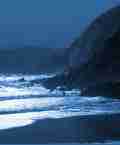

Trim Castle,
County Meath
Trim Castle is the largest and one of the most important Norman military constructions in Ireland. Its well-deserved reputation as the king of Irish castles rests upon its imposing curtain walls enclosing over three acres, its fine gatehouses and its enormous isolated keep - all of which project a visually striking image of foreboding might and great power. The first fortification on this site above the banks of the Boyne was a motte erected by Hugh de Lacy in 1172. After this was destroyed by Roderick of Connaught in 1174, de Lacy embarked on building another castle, the nature of which has not yet been established. On the basis of the present limited evidence, it seems likely that the curtain wall and the huge stone keep, which envelopes the stump of the old motte, were begun by de Lacy during the 1170s. Work may still have been proceeding when King John came here in 1210, for the following year, after the Crown had taken control of the castle, the sum of £64 was spent on building work, including "22/- for a large horse ... for strengthening the tower". The keep was probably being completed around this time.
The design of the keep is most unusual, comprising a massive square block with towers projecting from the middle of each face (only three out of the original four remain). On plan it looks like a combination of a square and a Greek cross. The towers have thinner walls than the main core and appear to have been added, not for defensive reasons, but to provide extra rooms and possibly because they looked good. Three of the four projections have ground floors, but the main core of the keep at this level is evidently filled with earth. The curtain walls at Trim, two-thirds of which still stand, had a perimeter of 500 yards. They must have been completed by 1224 when William Marshall besieged the castle for seven weeks, for it is unlikely the castle could have withstood his army for such a period without the protection of the curtain walls. There appears to have been a barbican on the town side of the west entrance which was further protected by a murder hole, a portcullis, the gate, and a second murder hole through a hole in the passage. It is often claimed that the upper rooms of this gatehouse were used to house the young Prince Hal, later Henry V, who was left at Trim by Richard II in 1399 before his fateful return to England. An extensive excavation was carried out in the 1970s in the area between the keep and the south curtain wall. This revealed a stone plinth added to the keep, parts of a ditch possibly dug around the keep and a number of ancillary buildings. It is to be hoped that more excavations will be carried out in the keep itself and in the area near the north tower, where it is evident that the Great Hall of the castle once stood.
Trim. NGR: N 202564.
Click here Irish Castles to buy the newly reformatted book from Amazon.co.uk. The previous edition of Irish Castles is also still available from Amazon.co.uk.
